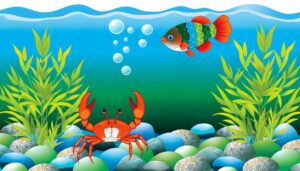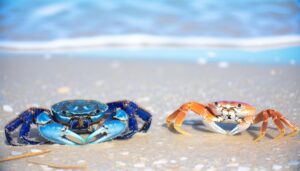Why Do Blue Crabs Turn Red When Cooked?
Blue crabs primarily breathe underwater using specialized gills housed in branchial chambers. These gills have filaments that maximize surface area for efficient gas exchange.
While they mostly extract oxygen from water, blue crabs can also absorb oxygen from the air if their gills remain moist. This capability allows them to survive short forays onto land, provided they maintain moisture on their gills.
Their adaptive behavior, such as burrow-digging and nocturnal activity, supports this terrestrial respiration. Environmental impacts like reduced oxygen levels and increased sedimentation can affect their gill function.
Learn more about how blue crabs navigate these challenges for survival.
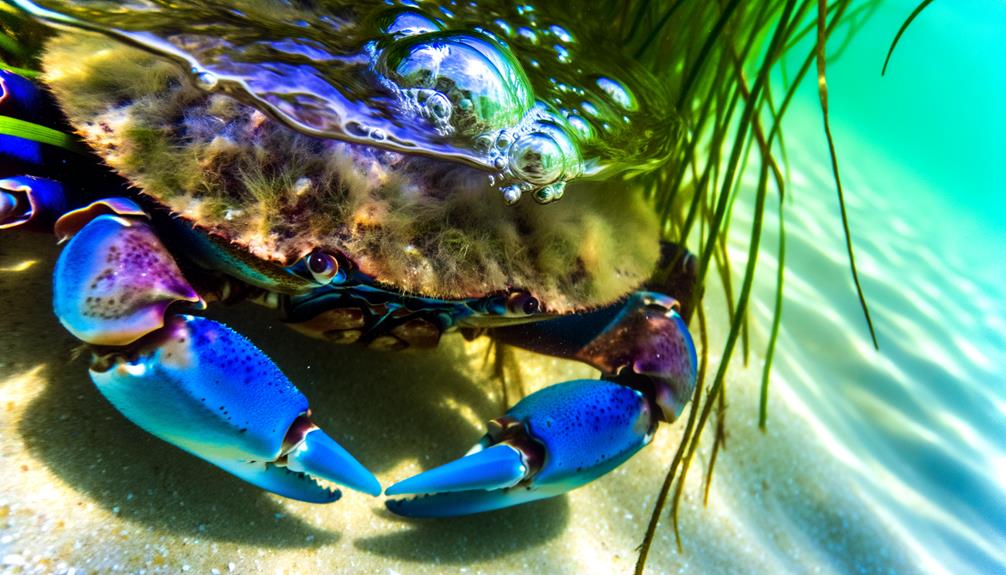
Key Takeaways
- Blue crabs primarily breathe underwater using gills located in branchial chambers.
- Their gills can absorb oxygen from water, even in low-oxygen environments.
- Blue crabs have limited ability to breathe air and need moisture to keep gills functional.
- They periodically return to water to wet their gills, ensuring effective gas exchange.
- Behavioral adaptations like burrow-digging and nocturnal activity help maintain gill hydration on land.
Blue Crab Anatomy
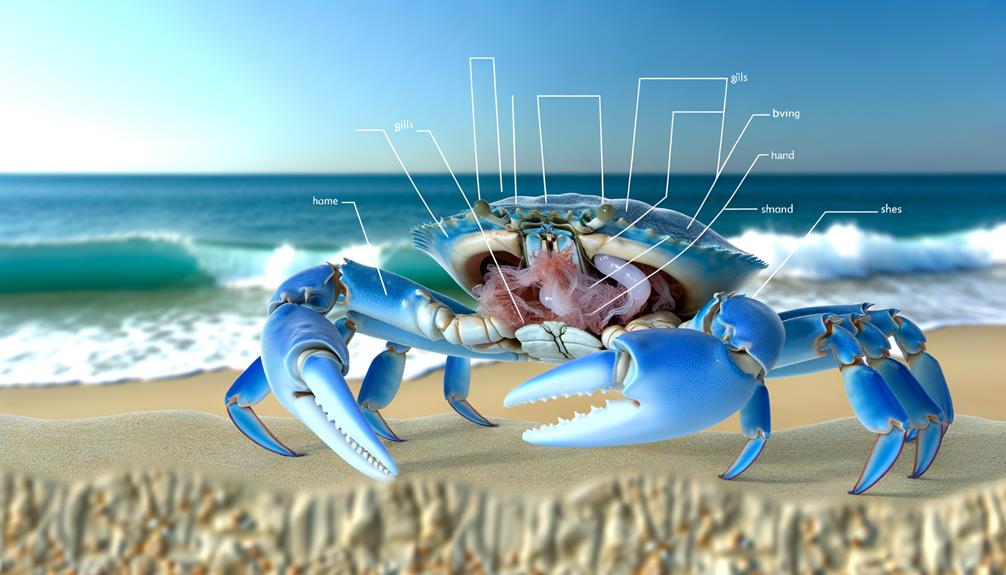
The blue crab's anatomy is intricately designed with specialized organs that support its aquatic lifestyle. You'll notice their hard exoskeleton, which provides protection and structure. Their segmented body includes a cephalothorax and an abdomen.
Blue crabs possess five pairs of legs; the first pair, called chelipeds, are strong claws used for defense and feeding. The remaining pairs are walking legs, with the last pair modified into swimming paddles, allowing for agile movement in water.
Internally, blue crabs have a complex digestive system, featuring a stomach with chitinous teeth that grind food. Their nervous system includes a decentralized nerve net and ganglia, ensuring responsive motor control. This precise anatomical framework enables them to thrive in their watery domains.
Gills and Respiration
When examining how blue crabs breathe, you'll find they rely on specialized gills designed for efficient underwater respiration. These gills are located in the branchial chambers within the crab's carapace. The gills consist of filaments that maximize the surface area for gas exchange. Oxygen diffuses from the water into the blood vessels within the gills, while carbon dioxide exits the bloodstream.
You'll appreciate how the crab's hemolymph (its blood equivalent) transports oxygen throughout its body. This process ensures that the crab's metabolic needs are met even in low-oxygen environments. Understanding this intricate respiratory system highlights how blue crabs thrive in diverse aquatic habitats.
Their gills' efficiency is a marvel of evolutionary adaptation, liberating them from the constraints of air-breathing.
Underwater Breathing Mechanics
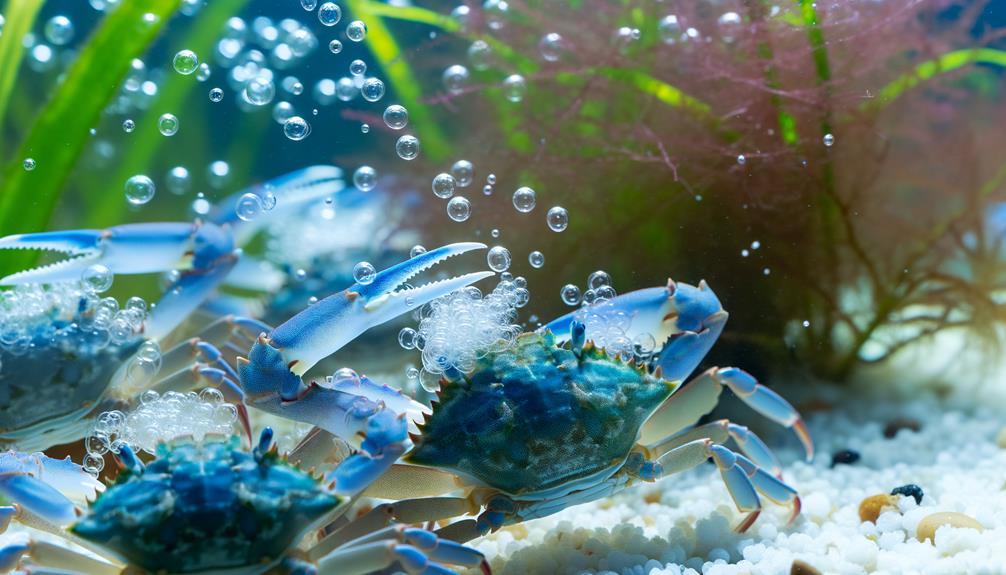
You'll find that blue crabs rely heavily on their gills for underwater breathing. The gills' intricate structure maximizes surface area for efficient gas exchange. As water flows over the gill filaments, oxygen dissolves and diffuses into the bloodstream while carbon dioxide is expelled.
This process, driven by differences in partial pressure, guarantees that the crab maintains proper oxygen levels even in varying aquatic conditions.
Gill Functionality Explained
Blue crabs utilize specialized gills to extract oxygen from water, enabling efficient underwater respiration. These gills, finely structured with lamellae, maximize surface area for gas exchange. Water flows over the gill filaments, and through diffusion, oxygen enters the crab's bloodstream while carbon dioxide is expelled. The intricate design guarantees best oxygen absorption even in low-oxygen environments.
Here's a glimpse into the wonders of their gills:
| Feature | Function | Emotion |
|---|---|---|
| Lamellae Structure | Increases surface area | Awe |
| Gill Filaments | Facilitates water flow | Fascination |
| Diffusion Process | Efficient gas exchange | Admiration |
| Gill Location | Protected under the carapace | Curiosity |
| Adaptability | Thrives in diverse habitats | Inspiration |
The gill functionality not only showcases nature's ingenuity but also offers a glimpse into the blue crab's adaptability.
Oxygen Absorption Process
The underwater breathing mechanics of blue crabs involve a meticulously coordinated process. Water is drawn over the gill filaments, allowing oxygen to diffuse efficiently into the bloodstream. You'll notice how the crab's gills, resembling feathery structures, maximize surface area to enhance oxygen absorption.
When water flows over these gills, oxygen molecules pass through thin membranes into the hemolymph, the crab's blood equivalent. Specialized cells in the gill epithelium facilitate this gas exchange. Concurrently, carbon dioxide diffuses out of the hemolymph into the surrounding water, maintaining a balance critical for survival.
This dual exchange system enables blue crabs to thrive in their aquatic environments, ensuring they extract every bit of oxygen necessary for their metabolic needs.
Oxygen Absorption Process
You'll find that blue crabs utilize specialized gills for oxygen uptake, efficiently extracting oxygen from water. These gills contain numerous filaments that increase surface area, optimizing gas exchange.
When exposed to air, blue crabs adapt by retaining moisture in their gill chambers, allowing limited terrestrial respiration.
Gills and Oxygen Uptake
Unlike land-dwelling creatures, blue crabs extract oxygen from water through specialized gills located in their branchial chambers. These gills are feathery structures that maximize the surface area for gas exchange.
Water flows over the gill filaments, allowing dissolved oxygen to diffuse into the crab's bloodstream while carbon dioxide exits. You'll find that the crabs' hemolymph, a fluid analogous to blood, transports oxygen to tissues efficiently. The gill lamellae, thin and numerous, make this exchange highly effective.
Air Exposure Adaptations
When blue crabs find themselves exposed to air, they utilize their gill chambers to trap moisture, enabling the gills to continue absorbing oxygen efficiently.
In this process, the gill chambers remain slightly wet, creating a humid microenvironment that facilitates gas exchange. You'll notice that the gills have a high surface area, maximizing oxygen absorption even in air.
The hemolymph, acting like blood, carries the absorbed oxygen throughout their body, ensuring cellular respiration continues uninterrupted.
Adapting to Brackish Water
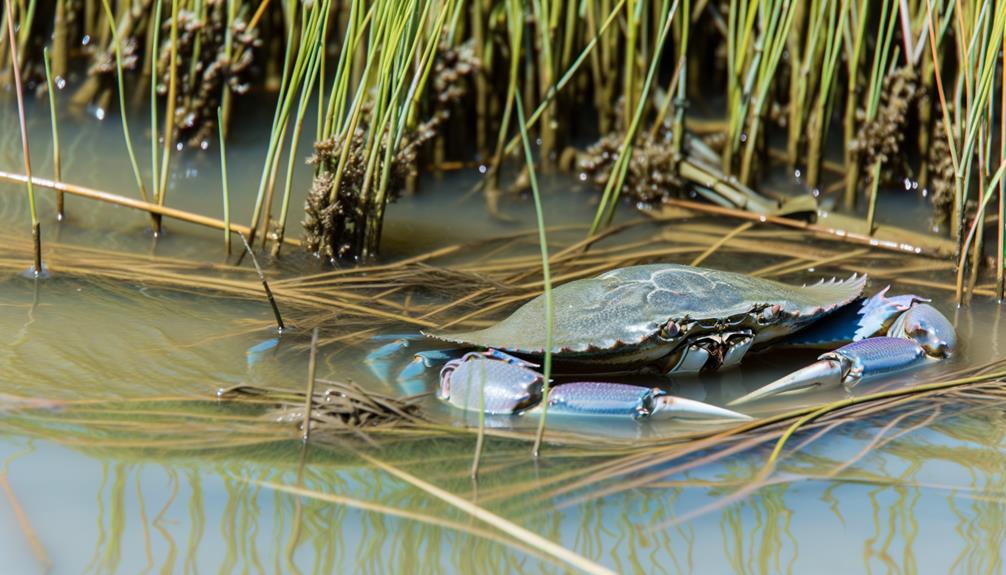
Blue crabs display remarkable physiological adaptations that enable them to thrive in the changing salinity levels of brackish water environments. Their gills can efficiently regulate ion exchange, allowing them to maintain osmotic balance. You'll find that their hemolymph (crab blood) adjusts its ion concentration to match external changes in salinity. This adaptability ensures their survival in estuarine areas where freshwater mixes with seawater. Additionally, specialized cells in their gills actively transport salts, a crucial process for their homeostasis.
| Adaptation | Function |
|---|---|
| Ion-Regulating Gills | Maintains osmotic balance |
| Hemolymph Ion Adjustment | Matches internal ion concentration to salinity |
| Salt Transport Cells | Actively transport salts for homeostasis |
| Osmotic Flexibility | Allows survival in varying salinity levels |
These mechanisms are necessary for blue crabs' resilience in fluctuating environments.
Air Exposure Challenges
One significant challenge blue crabs face during air exposure is the risk of desiccation, which can severely impair their gill function and overall respiratory efficiency.
When exposed to air, blue crabs' gills can dry out rapidly, losing the moisture essential for gas exchange. This desiccation reduces their ability to absorb oxygen from their environment, leading to respiratory distress.
Additionally, air exposure can alter the delicate balance of ions and other solutes within their gill tissues, disrupting cellular processes. As a result, blue crabs must navigate the complex interplay between maintaining hydration and ensuring effective respiration.
You'll find that these factors significantly limit their ability to remain out of water for extended periods, highlighting the physiological constraints they face.
Surviving on Land
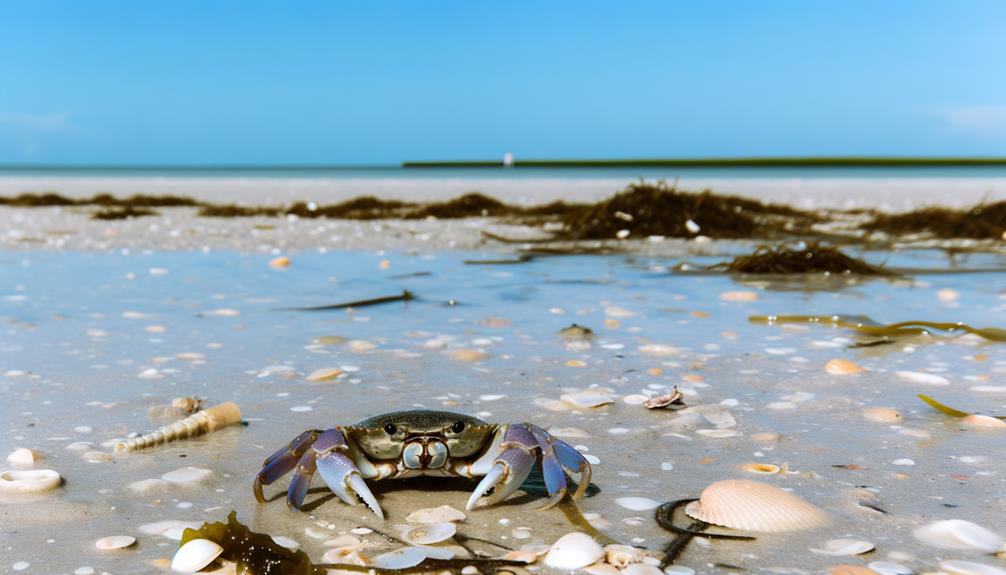
Despite their aquatic origins, blue crabs have developed several physiological adaptations that enable them to survive brief periods on land.
You'll notice these adaptations primarily in their exoskeleton and limb structure. Their exoskeleton retains moisture, essential for preventing desiccation. They also have articulated limbs, allowing for efficient locomotion on uneven terrain.
Additionally, their sensory organs, such as compound eyes and antennae, are highly adaptable, providing excellent spatial awareness and predator detection.
These adaptations collectively allow blue crabs to exploit terrestrial environments temporarily, escaping predators or seeking new habitats. However, their land survival is limited to short durations due to their reliance on aquatic conditions for essential functions like feeding and prolonged respiration.
Moisture and Breathing
Maintaining a moist environment around their gills is essential for blue crabs to efficiently extract oxygen from the air when they're out of the water. Without moisture, their gills would dry out and fail to function properly.
Here's how moisture aids in their breathing:
- Oxygen Absorption: Moisture keeps the gill filaments hydrated, facilitating the diffusion of oxygen from air to blood.
- Surface Area: Wet gills maintain their structure, providing a larger surface area for gas exchange.
- Prevents Desiccation: A moist environment prevents the gills from desiccating, ensuring they remain functional.
- Mucus Production: Moist conditions enhance mucus production, which captures oxygen and aids in its transport.
Gill Function Outside Water
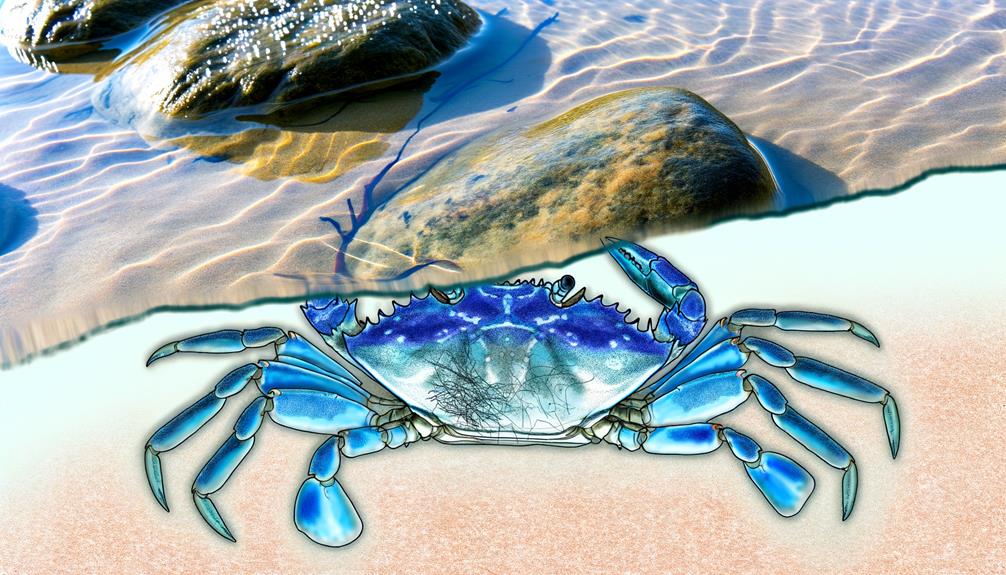
When blue crabs are out of water, their gills must still facilitate gas exchange by extracting oxygen from the air. A process that hinges on the gills' ability to remain moist.
You'll find that their gills are highly vascularized, maximizing oxygen absorption. Moisture enables the thin gill filaments to effectively transfer oxygen into the bloodstream and expel carbon dioxide.
Without water, crabs rely on ambient humidity to keep their gill surfaces wet. This anatomical adaptation ensures that oxygen diffuses across the gill membranes.
Crabs can temporarily sustain themselves using this mechanism, but prolonged exposure to dry environments leads to desiccation. Understanding this process underscores how blue crabs balance their aquatic nature with occasional terrestrial ventures.
Behavioral Adaptations
Given the gill's dependency on moisture, blue crabs have developed specific behavioral adaptations to guarantee their respiratory needs are met when they venture onto land. These adaptations make sure they maintain the necessary moisture levels for efficient gas exchange.
You might find these behaviors fascinating:
- Burrow-Digging: Blue crabs dig burrows in moist sand or mud to retain humidity and protect their gills.
- Nocturnal Activity: They often come onto land at night when humidity levels are higher, reducing desiccation risks.
- Gill-Wetting: They periodically return to the water to wet their gills, ensuring they stay functional.
- Body Positioning: By angling their bodies, they maximize airflow over their gills, optimizing respiration.
These behaviors highlight the blue crab's remarkable adaptability in balancing their aquatic and terrestrial needs.
Environmental Impacts
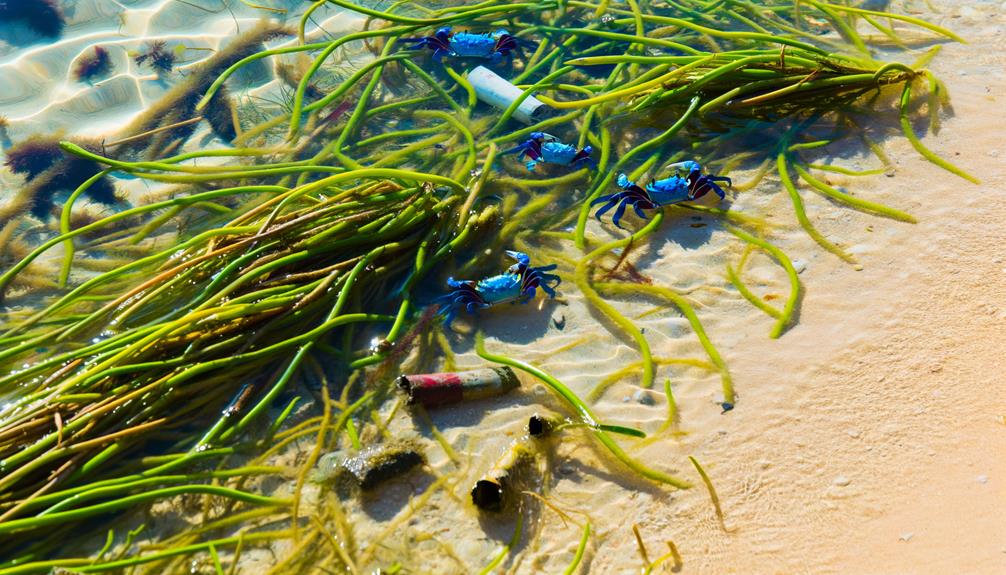
You should consider how habitat degradation affects blue crabs, as it disrupts their breeding and feeding grounds.
Pollution and water quality directly impact their ability to breathe and thrive, given their reliance on gill function.
Additionally, climate change alters temperature and salinity levels, posing further challenges to their survival.
Habitat Degradation Effects
How does habitat degradation impact blue crabs' respiratory mechanisms and overall survival in their natural environment?
Habitat degradation disrupts the delicate balance of ecosystems essential for blue crabs. When you observe these impacts, you'll notice:
- Reduced Oxygen Levels: Degraded habitats often lead to lower dissolved oxygen, necessary for blue crabs' gill function.
- Loss of Vegetative Cover: Vegetation loss reduces hiding spots, increasing stress and energy expenditure, thereby affecting respiration.
- Sedimentation Increase: Excessive sediment can clog gills, impairing the crabs' ability to filter water effectively.
- Temperature Fluctuations: Degraded habitats are prone to temperature changes, which can stress crabs and disrupt their metabolic and respiratory processes.
Understanding these factors is essential for ensuring blue crabs' survival and maintaining ecological balance.
Pollution and Water Quality
Pollution and compromised water quality critically undermine blue crabs' respiratory efficiency and overall health by introducing toxins that directly affect their gill function and metabolic processes. You'll find that heavy metals, pesticides, and industrial runoff accumulate in their habitats, impairing their ability to filter oxygen through their gills.
This leads to hypoxia, a condition where oxygen levels are dangerously low, further stressing their metabolic systems. Additionally, nutrient pollution fosters algal blooms, which deplete oxygen and release harmful compounds. These environmental stressors don't just impact individual crabs; they destabilize entire populations.
Climate Change Consequences
Rising sea temperatures and ocean acidification, driven by climate change, profoundly disrupt blue crabs' physiological processes and habitats, ultimately threatening their survival.
You need to understand how these environmental shifts impact them:
- Metabolic Stress: Higher temperatures increase the crabs' metabolic rates, causing them to consume more oxygen and energy, which can lead to exhaustion and mortality.
- Molting Issues: Acidification weakens the calcium carbonate structures in their exoskeletons, making molting difficult and increasing vulnerability to predators.
- Habitat Loss: Rising sea levels and changing salinity levels alter the crabs' coastal habitats, reducing areas where they can thrive.
- Food Chain Disruption: Changes in water chemistry affect the availability of prey species, leading to food scarcity and nutritional stress for blue crabs.
Understanding these impacts helps you grasp the broader consequences of climate change on marine life.
Comparative Species Analysis
Although blue crabs primarily rely on gills for respiration, understanding how their respiratory mechanisms compare to those of other aquatic and semi-aquatic species is crucial.
Blue crabs use specialized gills that efficiently extract oxygen from water, similar to fish. However, they can also survive in air for limited periods, provided their gills remain moist.
Contrast this with mudskippers, which have evolved to breathe through both gills and skin to thrive in intertidal zones.
Amphibious crabs, like the mangrove crab, take this adaptation further by developing lung-like structures.
Human Interaction Effects
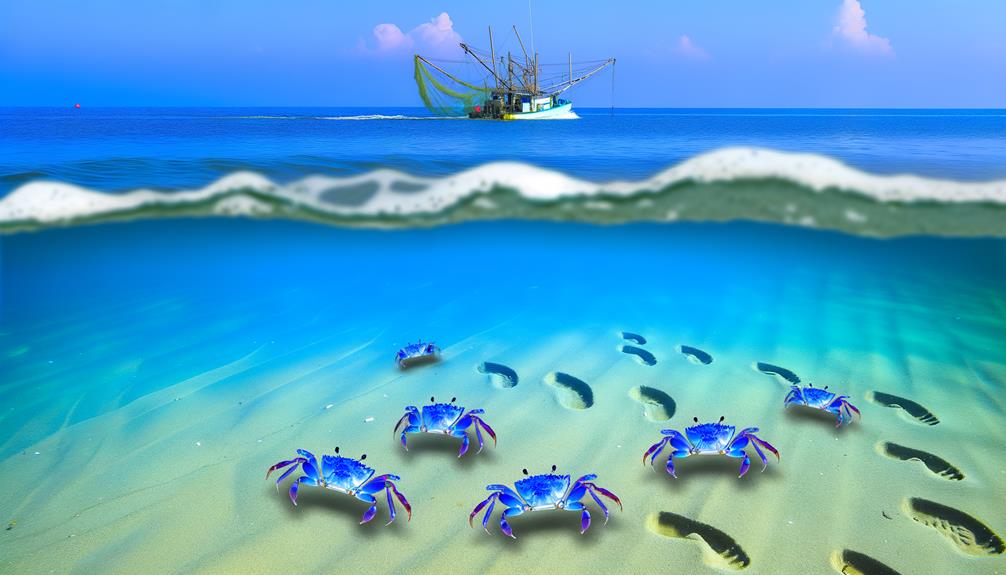
In recent decades, human activities have greatly impacted blue crab populations through habitat destruction, overfishing, and pollution, necessitating urgent conservation measures to preserve these essential marine organisms.
You can help mitigate these effects by understanding and addressing the following key issues:
- Habitat Destruction: Coastal development and land reclamation reduce the vital estuarine environments where blue crabs thrive.
- Overfishing: Unsustainable harvesting practices deplete blue crab populations faster than they can reproduce.
- Pollution: Chemicals and waste from industries and agriculture contaminate the water, harming blue crabs' health and reproductive capabilities.
- Climate Change: Rising temperatures and sea levels alter blue crabs' habitats, making them more vulnerable to various stressors.
Addressing these factors is essential for ensuring the sustainability of blue crab populations.
Conclusion
Imagine you're a scuba diver exploring the underwater world. Just as you rely on your gear, blue crabs depend on their gills to extract life-giving oxygen from the water.
When the tide recedes, they're like mariners adjusting to the ebb and flow, utilizing specialized behaviors and physiology to survive.
Understanding their intricate dance with the environment reveals not just their resilience, but also the delicate balance sustaining aquatic life and its interconnected ecosystem.

